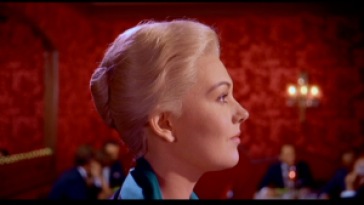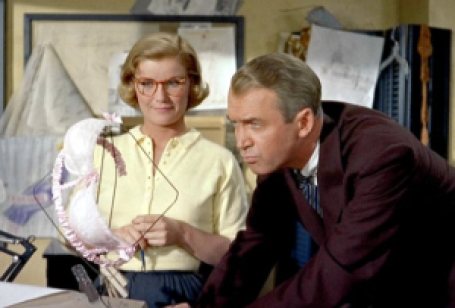The worst thing that can happen to “Vertigo” after being named the Best Movie of All Time by Sight and Sound is that the movie will turn into homework.
For decades, “Citizen Kane” carried the burden of being seen as a good helping of cultural vegetables. I know how people are. They think they’ve seen a lot of movies in their life, then stumble across a list like Sight and Sound and proceed to boastfully challenge the top choice.
“I don’t see what makes it so great.” Maybe if the Sight and Sound poll weren’t treated like a figurative film canon, then maybe people wouldn’t be so quick to write off masterpieces as stodgy, arty, no fun movies for critics and old people.
So naturally upon rewatching “Vertigo” with my family, I quickly asked my dad if he knew why “Vertigo” was considered worthy of the number one spot. He gave the best answer I could’ve imagined. “Because other movies just aren’t as good?”
In terms of film auteurs, Alfred Hitchcock is far and away the most approachable, the least “challenging,” the least stodgy and often the most fun. His films are technical flourishes. Where other directors fail to set the mood, where other directors use a plot device that is all too obvious or where other directors incorporate a twist that is all too ridiculous, Hitchcock never stepped wrong.
We call him the master of suspense because he brought no-nonsense thrills into the cinema and became a household name before anyone else. If his movies lacked the emotional heft of other Old Hollywood classics, it’s because he played his films with such virtuosity and perfection that stray feelings never got in the way.
“Vertigo” on the other hand is his most personal and his most emotionally complex. That’s why this is in the number one spot; because it’s excellent.
For those who haven’t seen it, I need not ruin the greatest film ever made, so spoilers will come later. But it’s a story of a detective, John “Scottie” Ferguson (James Stewart), who while out in the field tailing a suspect on a rooftop, is incapacitated by a fear of heights and ultimately allows one of his colleagues to fall to his death.
We flash forward to him being cured of his injuries, but his burden is his guilt that his disability has caused him. Now out of the game, an old friend contacts him to investigate the behavior of his wife, Madeline Elster (Kim Novak). Her husband Gavin (Tom Helmore) believes she has become possessed by a spirit. Suddenly she’s absent minded, distant and another person altogether.
Scottie begrudgingly takes the case and finds out she’s living out the actions of Carlotta Valdes, a woman who committed suicide decades earlier. When Madeline attempts the same, Scottie becomes obsessed and attached to her and her survival.
“Vertigo” is a movie of being completely obsessed and entranced. Part of the reason it’s called Hitchcock’s masterpiece is because everything we’ve known about Hitchcock the director comes through in this film. The film’s style, setting, story and characters all reflect traits that had been common to each of his films, and we finally get a sense of Hitchcock’s greatest fears and fetishes.
So when we see Kim Novak’s beautiful blonde hair bursting from behind bright red restaurant walls or from verdant bouquets in a flower shop, Hitchcock’s fascination, Scottie’s obsession and our own puzzlement are all mutual. We first really meet Madeline when she’s lying naked in Scottie’s bed after her near tragic accident. This is arguably any guy’s fantasy, not just Hitch’s.
But Madeline has this mystique that someone like Scottie’s friend Midge (Barbara Bel Geddes) doesn’t have. Poor Midge. She tries so hard to be loved and noticed by Scottie. They have such great, amicable chemistry. She designs bras for a living and wears giant ones herself to stand out. She’s a blonde too. But she’s always dressed in soft colors and her apartment has a calming atmosphere that old Scottie can hardly notice.
Like us, he’s too obsessed with the films many other colors. “Vertigo” could never have been made in black and white. Its Technicolor is too strongly associated with different feelings and emotions. Hitchcock manipulates them in dream sequences and in chases to play off the film’s themes. Green is Scottie’s lust and envy for Madeline, blue is his guilt and red is his warning sign. This is just a brief rundown of the film’s colors that Jim Emerson summarizes beautifully here.
The colors help Hitchcock’s cause when he molds the beginning into a silent but striking detective procedural. The visages throughout the San Francisco setting are enticing enough to allow the chase to continue free of dialogue. Although not every shot is designed to look gorgeous, no shot seems to be wasted to detail exactly where Madeline is headed and how Scottie reacts. Jimmy Stewart plays these moments with subtle expressions that make him more of a voyeur than a detective. Watch how his face changes ever so slightly to indicate to us that Madeline is wandering aimlessly on her way back to his house and bright red door.
Hitchcock leaves other visual clues. As he tails Madeline into the museum, his massive shadows seem to go before him, suggesting that he is outside himself and his actions are somewhat beyond his control. The museum itself is framed such that the pillars are dwarfing and that as Scottie peers into the gallery to see Madeline, he may as well be scrutinizing his own painting of her.
SPOILERS AHEAD.
Hitchcock uses all these devices to wrap us so fully in this story. Those who have seen the film know that this is all an act. She’s not Madeline, but Judy, a redhead from a small town in Kansas. Roger Ebert had pointed out to him in a shot-by-shot study of “Vertigo” that Madeline’s suicide attempt into San Francisco Bay is not all that desperate because it’s Judy playing a part.
But there are two things that fact overlooks.
Most modern thrillers with a big twist have Easter Eggs dropped all over them to signal that all is not right. Anyone who has seen the movie can pick up on them and realize how intricate a construction the director has built. Think “Black Swan,” another complex movie about multiple identities. In Darren Aronofsky’s film, you’ll know right from the get go that Natalie Portman is acting out two sides of her psyche.
Hitchcock doesn’t leave any clues. We have no reason to doubt that Madeline is not Madeline (we never actually see the real Madeline Elster), or that Elster may be lying (his only tell is that he hates his job that he married into, which ultimately motivates him to kill his wife). We become obsessed with THIS story, not the next one. The Carlotta subplot is intricate enough that it might be true. Stranger things have happened, even if not in a Hitchcock film. When he shows you the twist, you don’t really want to believe it. But then why would the movie lie? And there’s genuine infatuation between Scottie and Madeline. Their scene in the forest isn’t seen as a lie because of the way Hitchcock casts a hazy, green silhouette over the whole occasion. The colors fit with our sensation that this is the obsession we should be following.
But the second thing to notice is that Judy isn’t really acting. As I said, “Vertigo” is a film about obsession, and Judy is as much a slave to the part of Madeline as Scottie is to her. When Judy again transforms into Madeline for Scottie’s sake, the scene is so horribly uncomfortable and queasy because we realize that she’s as psychologically sick as Scottie is. She doesn’t have the nerve she mentions in her letter to Scottie to pull herself away from the part of Madeline, nor the love of Scottie.
“If I let you change me, will that do it? If I do what you tell me, will you love me?” Judy begs to Scottie. “All right then, I’ll do it. I don’t care anymore about me.” Judy and Madeline are two very different people. When she confesses to this, the real Judy is already dead, and when Scottie no longer needs Madeline, she’s only moments away from jumping off that bell tower a second time.
You get this sensation because Kim Novak does give a wonderful dual performance. Her presence as Judy is distinctly different and not immediately infectious in the way Madeline is. She also gives off the sensation that she knows Scottie is completely lost and hopeless. It doesn’t prevent her from trying to get things back to normal (and it almost works), but Scottie is in love with an idea or a symbol, not a woman.
SPOILERS DONE.
In the end, the twist reveals “Vertigo’s” story structure as another case of an innocent man being framed, which is the most common trope in all of Hitchcock. Hitch takes bold innovations in this film by tinkering with animation, lighting and transitions that veer slightly from reality (the infamous Trombone shot looking down the stairs), but he doesn’t stray far from his roots.
The Bernard Hermann score is a lush reminder of the film’s romanticism. The obvious hints to key into the suspense, such as the curl in Madeline’s hair or the red necklace, are all here. And Hitch’s characters and story leaves no ambiguity.
This is 100 percent a Hitchcock film, not a masterpiece that succeeds by completely shattering the formula Hitchcock had worked all his career to perfect.
If Hitch is the greatest director to ever live and “Vertigo” is his best film, then logically it is the best movie of all time. It’s riveting, heartbreaking, intense and beautiful. It really is just that much better than a lot of other films.
But like its characters, “Vertigo” is two movies. One side is the sheer entertainment that shouldn’t be treated like homework. The other is the greatest personal accomplishment of an artist before being a director also meant being an artist. Hitchcock didn’t play every role in the production the way Orson Welles did with “Citizen Kane;” He found a new way to put himself into every moment.







